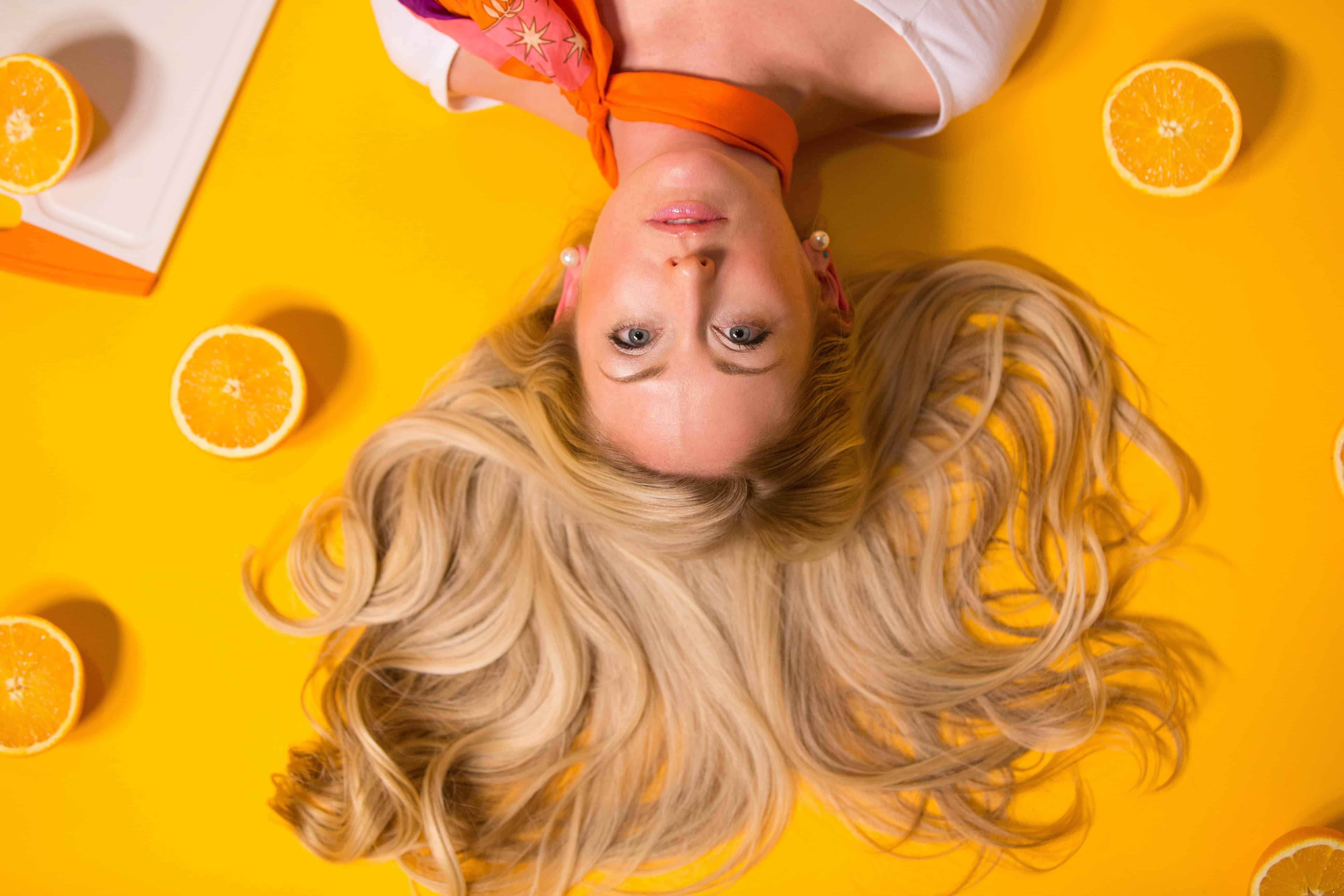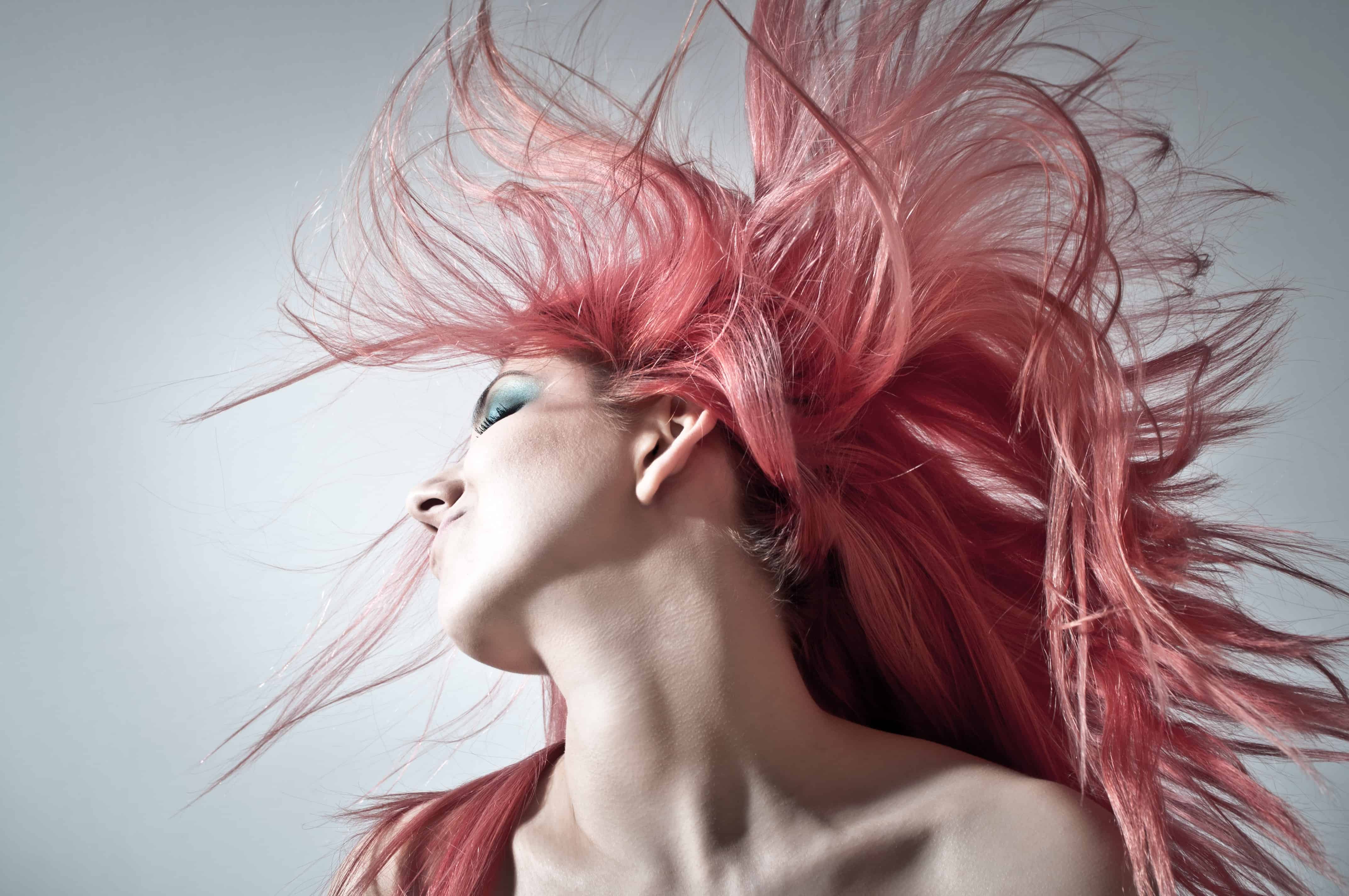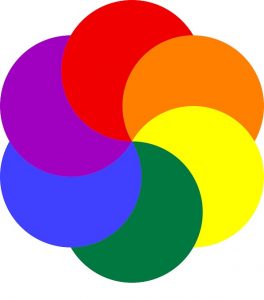[et_pb_section fb_built=”1″ _builder_version=”3.0.47″][et_pb_row custom_padding=”0|0px|13px|0px|false|false” _builder_version=”3.0.48″ background_size=”initial” background_position=”top_left” background_repeat=”repeat”][et_pb_column type=”4_4″ _builder_version=”3.0.47″][et_pb_text admin_label=”Text” _builder_version=”3.0.74″ background_size=”initial” background_position=”top_left” background_repeat=”repeat”]
The color wheel contains the 11 levels of natural hair color along with the several different shades and hues for each of the levels. To master the color wheel and to become an expert colorist you must understand each of the color levels along with how each of the colors match, neutralize or intensify each of the shades.
Color Wheel
Primary colors – Blue • Red • Yellow
Secondary colors – Green • Orange • Violet
Tertiary colors – Blue-green • Blue-violet • Red-violet • Red-orange • Yellow-orange • Yellow-green
Primary colors – colors cannot be made. All three are what makes all possible colors
Secondary colors – colors that are made using two primaries
Tertiary colors – colors made from primary and secondary colors
How to use use the color wheel to match hair color
In order to match hair color, you must first locate what level you are at and what the existing shade is that you need to formulate for. For example, if you have grey roots growing in, and the previous color is washed out brown you must decide if you will match the lighter tone or deepen it depending on the desired result. Remember to check what underlying pigment the shade has. In order to cover grey hair, your formula must have a neutral base. neutral shades cover grey hair the best because all primary colors are present in the base. Colors that say neutral in them are formulated to give the best grey coverage.
How to use the color wheel to neutralize color
When using the color wheel to neutralize a specific color the answer is directly on the opposite side of the wheel. For example, to combat yellow tones a violet underlying pigment will be used to neutralize golden pigment. If your hair is brassy orange a blue-based pigment will counteract this tone and if your hair is red, a green-based pigment will reduce the red tone in the hair. Pinpointing the exact color level and using the guide across the wheel will give you a foolproof formula to neutralize hair colors like a master. Since everyone has a different perception of red, orange, warm, yellow and gold. Tweaking the neutralizing color will give custom results.

To neutralize color, look on the opposite side of the color wheel
When intensifying the tone in your hair the color wheel acts as a reference for several shades that can be used for different results. Say for example you have an orange like warm tone and you want to deepen it and add more of a mahogany type of red. The formula that you will mix will add a red violet like pigment to blend with the orange making it a deeper but cooler toned red hue. If you add the red alone it will leave it red but with a vibrant orange tone present. the violet-red cancels the bright orange and intensifies the cooler red and making it a rich mahogany tone.
When intensifying the tone in your hair the color wheel acts as a reference for several shades that can be used for different results

Red is intense.
How to read the color wheel; a breakdown of the hair color wheel chart and the underlying pigments or hues in each level:
-
- 11 white—platinum, gray, silver and salt-and-pepper strands: ash cool
- 10 pale blonde—pale yellow, vanilla: ash cool
- 9 blonde—yellow, beige, champagne: cool-neutral
- 8 medium blonde—yellow, golden, sandy neutral-warm but no red exist
- 7 dark blonde—yellow-orange, warm, honey, warm gold present
- 6 light brown—orange, copper, bronze, chestnut, warm gold-orange
- 5 medium brown—red orange, fiery, auburn, crimson
- 4 dark brown—red undertones, dark auburn, ruby, scarlet, red most present
- 3 darkest brown—deep red and violet undertones, eggplant, and mahogany
- 2 soft black—neutral, warm undertone, only visible if you put up to the light
- 1 blue-black—ash base underlying pigment, barely visible, cool deep blue base
How to use the color wheel to properly fill in hair
When color correcting using the color wheel can be a great tool when referring to what the underlying pigment needs to be. For instance, if you are blonde with a yellow undertone and desire to be a neutral dark brown. The hair must be filled in with the underlying pigment to receive a dark color. Going dark without filling can lead to improper toning, excessive ashy pigment or dull washed out strands. The blonde hair must be filled with a red color first. To fill the hair is to turn blonde hair the underlying pigment first. Red exist the most in dark brown hair. In order for the hair to look rich and full of deep chocolate tones. The filling should be done to keep the color lasting and have your clients gleam with excitement with their new hue.

How to use the color wheel when decolorizing, hair lightening and bleach
When decolorizing, the level chart will show you at each level and what underlying pigment is needed to create specific colors. If you are a level 3 darkest brown and desire honey brown highlights hair must first be decolored to a warm orangey tone then neutralized with a green blue-based light brown. Decolorizing is a must be if hair is not virgin. Performing highlights on someone who has dark dyes can delay the process and higher peroxide will need to be used to achieve maximum lifting. On virgin hair low volume can work well just a bit slower.
How to use the color wheel to mix hair colors and developers
Now that we have shown how the color wheel works in conjunction with hair color, we can show you how mixing colors with developers and get the targeted results you desire. Hair colors have level ranges from 1- 11 and can have vibrant, warm cool and neutral results in each of the levels. Depending on the natural level of the hair and the desired effect, different developer strengths will be used to get the job done. Developers determine if you are toning, getting maximum grey coverage or lifting more than 3 levels.
Hair colors have level ranges from 1- 11 and can have vibrant, warm cool and neutral results in each of the levels.
Developers strengths for hair color are hydrogen peroxide and are measured in volumes.

Violet mane.
The peroxide opens the cuticle so it can penetrate color molecules into the hair shaft. developers and their uses for hair color and lightening. developers are hydrogen peroxide liquid that works as an oxidizing agent for the hair color. The varying levels of developers depend on different hair color lines or manufacturers that make several options for their hair color products.
10 volume – 1 level lift or toning, refreshing, deepening. used with semi and demi-permanent colors, and hair lighteners. Timing can vary from the manufacturers’ recommendations. Responsible for maintaining shades intact and can be used on any level. also used with color extractors in removing artificial dyes or pigments as well.
20 volume – 2 levels of lift and maximum grey coverage. To be used with permanent colors and lighteners. Most popular for grey coverage and controlled lightening on virgin hair. when covering stubborn grey timing will vary between 30-45 minutes maximum. Also use color extractors to lift out black, dark deep pigments and red dyes before lightening.
30 volume – 3 levels of lift. When 3 shades are needed to lift on very dark natural levels. Can be used for speeding up lightener when faster lightening is needed. Will be used to lift out levels 4 and below and balance lightening when a pigment is so dark. great when a vibrant red or warm tone needs to be visible on dark natural levels.
40 volume – 4 levels of lift. easily lift out natural levels on all colors. Used for ultra light color series, will lift virgin hair to a blond shade on levels 6 and above. Not recommended for levels 5 and below unless warmer or red tones are desired. Can be used with lightener for stubborn hard to lift hair and when speed lightening is needed . not recommended for porous or over processed hair.
There are many companies that make several volumes for different products that they launch. There are volumes lower than 10 and will be called processing liquids. Anything lower than 10 V is only going to give you a hue or add red or deepen colors . can also change a hue in any levels. Like 10 V processing liquids are very gentle and if you like a particular color line and it has lower volume than 10 just know it is a weaker version of 10 volume.
The higher the peroxide level the more the cuticle opens and more careful you need to be using them.
Developers can also be higher than 40 giving lightning speed results. Not recommended when doing full highlights or for on scalp procedures. The higher the peroxide level the more the cuticle opens and more careful you need to be using them. Only effective in my opinion when spot lightening or a few strands of hi-lights would be done. When using with hair color no more than 45 minutes will be needed. Not recommended to use with hair lightener “bleach”. When used with lightener the strength is so severe that instant dryness or breakage can occur. Leaving strands over processed and feeling gummy and melted. A mistake you want to avoid. When going light with any developer testing elasticity periodically during color services are crucial. You don’t want the hair to stretch and break off.
[/et_pb_text][et_pb_social_media_follow _builder_version=”3.20.1″][et_pb_social_media_follow_network social_network=”facebook” _builder_version=”3.20.1″ background_color=”#3b5998″ follow_button=”off” url_new_window=”on”]facebook[/et_pb_social_media_follow_network][et_pb_social_media_follow_network social_network=”pinterest” _builder_version=”3.20.1″ background_color=”#cb2027″ follow_button=”off” url_new_window=”on”]pinterest[/et_pb_social_media_follow_network][et_pb_social_media_follow_network social_network=”instagram” _builder_version=”3.20.1″ background_color=”#ea2c59″ follow_button=”off” url_new_window=”on”]instagram[/et_pb_social_media_follow_network][et_pb_social_media_follow_network social_network=”linkedin” _builder_version=”3.20.1″ background_color=”#007bb6″ follow_button=”off” url_new_window=”on”]linkedin[/et_pb_social_media_follow_network][et_pb_social_media_follow_network social_network=”youtube” _builder_version=”3.20.1″ background_color=”#a82400″ follow_button=”off” url_new_window=”on”]youtube[/et_pb_social_media_follow_network][/et_pb_social_media_follow][/et_pb_column][/et_pb_row][/et_pb_section]
